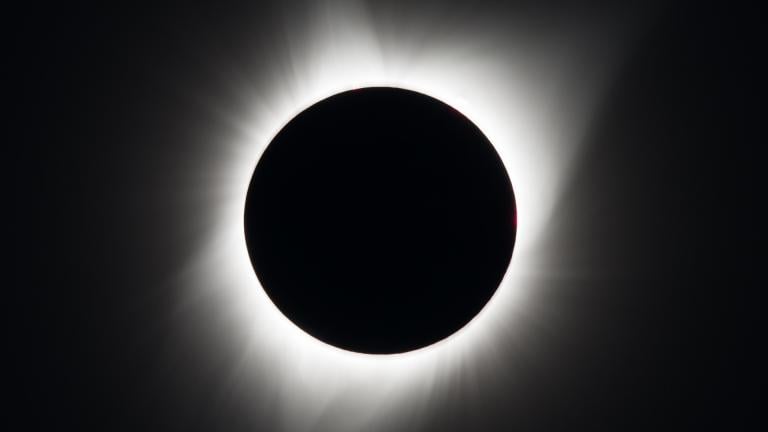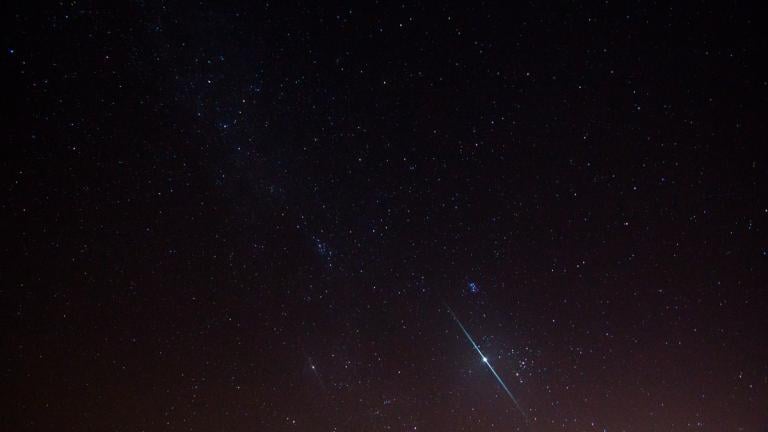Astronomers have long "heard" radio signals from outer space; they are frequently generated by natural phenomena like supernovas, which are exploding stars. But over the last eight years, some radio signals have been reaching Earth that are unlike any detected before, and scientists are at a loss to explain where they are coming from and why they have a very unusual characteristic. Lucianne Walkowicz, an Adler Planetarium astronomer, tells us whether earthlings may, at long last, be hearing from other intelligent life in the universe.
 Read an interview with Seth Shostak, senior astronomer at the SETI (Search for Extraterrestrial Intelligence) Institute.
Read an interview with Seth Shostak, senior astronomer at the SETI (Search for Extraterrestrial Intelligence) Institute.
The recent buzz on the possibility of extraterrestrial life comes from a study on fast radio bursts, which are described as pulses that last a few milliseconds and emit more energy than the sun does in a month. What exactly are fast radio bursts?
We don’t know. If I knew that, I would be on a plane to Stockholm to collect a check and have dinner with the king.
This really started in 2007, when an astronomer in Australia picked up on the first [fast radio burst] and people said, “We’ve never seen anything ever like this. We’ve seen flashes in the sky and radio signals, but nothing like this.” It’s kind of like what people say about religion—well, this could be interesting if true. Then, they found another 10. All but one were found with the same telescope and you got to say this is something.
The first clue is, it’s not in one spot in the sky; it’s coming from lots of places in the sky. So usually that means it’s some sort of cosmic phenomena, like pulsars or quasars, probably not E.T., not the Klingons, but something intrinsic to nature. The second clue is they’re pretty strong. The thought was since these things are coming from very far away, then whatever is making them has got to be really powerful. It can’t be your run-of-the-mill radio source. It has to be very, very powerful. The third clue is the dispersion measure; that’s a nerdy thing that gives an indication of how far away these babies are, and they all look like they’re really far, not just the next galaxy but billions of light years away.
How do fast radio bursts relate to extraterrestrial life?
We know there are lots of them and they’re very powerful. What can you think of that does that? Usually, colliding black holes or dead stars. But one cannot rule out that it’s alien – I’m not that idealistic even though looking for aliens is my day job. There’s a short laundry list of possibilities.
I read that supernovas were ruled out.
Yes, one of the astronomers who discovered them was saying it’s not a supernova, which happens at the death of a star, because when they go off, you get light and radio waves. If these things were supernovae, you would see the light too because big stars die in a blaze of glory.
You mentioned dispersion measures, which is the other interesting thing about this study. All of the dispersion measures are integer multiples of 187.5. What does this signify?
I was doing a radio show with a guy and he was doing numerology on this thing: “It’s the station number, obviously it’s a code, it’s a message, you know.” It can’t be anything like that. They looked at the 11 radio bursts and found this number. I wrote this in the Huffington Post: It’s like in your class, you weigh all those students and all their weights are multiples of 20. You say, “There’s something weird about this class, it must mean something.”
So the sample size is too small to mean anything.
There’s a tendency to think there’s some sort of periodicity, some sort of arrangement. But when you get more data, it usually goes away. When you measure more than 11, when you have 1,100 and that pattern’s still there, then it’s telling you something very interesting.
 You work for the SETI Institute whose mission statement is to look for evidence of life. Tell me about SETI’s research.
You work for the SETI Institute whose mission statement is to look for evidence of life. Tell me about SETI’s research.
The majority of SETI scientists are looking for life in our solar system, stuff you’d need a microscope to see. Are there bacteria in the sands of Mars, the liquid oceans of Jupiter, the moons of Saturn that look very promising? It’s going to be microbial, not little green guys asking to be taken to the mayor of Chicago. That’s where all the effort and money is.
The group I direct is looking for intelligent life, like what Jodie Foster is doing in Contact. We have instruments in the Cascade Mountains in California and we point it at nearby stars hoping to pick up a radio signal.
Any luck so far?
If we found something, you would know, you wouldn’t have to ask. But I’m optimistic. We’ve only looked at a very tiny fraction of the galaxy. When we’ve looked at 1 million galaxies, we’ll find something.
Scientists have also tried sending things into space with the hope that it will reach intelligent life. Can you tell me about that?
That’s called an active SETI [Search for Extraterrestrial Intelligence]. Most famously, there was a broadcast in 1974, using that antenna in Puerto Rico. NASA sent a Beatles song in 2008. There was a Dorito ad broadcast. That was a stunt of course but there are people who want to do it for real. Now, there are people who are worried that the aliens will come and incinerate the planet. I don’t think we should be worried about it. That horse has left the barn.
Given that extraterrestrial life may exist light years away, what are the chances we’ll hear anything back in our lifetime?
The chances you’ll get something back are not terribly high. Thirty light years is about one human lifetime. That range is close to 1,000 stars and I don’t think that’s enough. But it’s instructive to do it. It tells you about the whole effort of broadcasting. I think there’s some value in that and seeing what people would want to send.
Anything else you want readers to understand about the study or the search for extraterrestrial life?
It’s a special time. We have enough knowledge. We have the equipment. NASA’s Kepler Space Telescope tells us that something like 1 in 5 stars has a planet more or less like earth. If that’s true, then the number of planets [in the Milky Way galaxy] is like at least 50 billion. And that’s just in our galaxy. So to say this is the only place where anything interesting is happening, it can’t be true, unless we’re a miracle. And in science, it’s never smart to assume anything is a miracle.
Interview has been condensed and edited.
Watch Shostak's 2012 TED talk, "ET is probably out there -- get ready."








